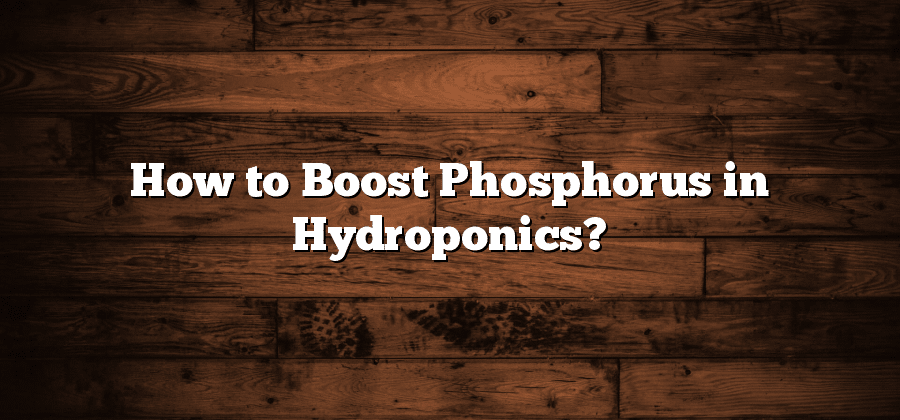Understanding Phosphorus Requirements in Hydroponics
Hydroponics is a popular method of growing plants without soil, and understanding the phosphorus requirements is crucial for achieving optimal growth and yields. Phosphorus, one of the essential macronutrients, plays a vital role in various plant functions such as energy transfer, root development, and flower and fruit formation.
In a hydroponic system, phosphorus is typically supplied to the plants through nutrient solutions. These solutions are carefully formulated to provide the necessary nutrients in the correct proportions. When selecting phosphorus-rich nutrient solutions, it is essential to consider the specific requirements of the plants you are growing. Different plants have varying levels of phosphorus needs, and providing them with the right amount is vital for their overall health and performance. Regular monitoring of the nutrient levels in the solutions and making adjustments as needed is critical to ensure optimal phosphorus supply to the plants.
Selecting Phosphorus-Rich Nutrient Solutions for Hydroponics
Phosphorus is an essential nutrient for plant growth and development in hydroponics. Selecting the right phosphorus-rich nutrient solutions is crucial in ensuring optimal plant health and productivity. When choosing a nutrient solution, it is important to consider the concentration and availability of phosphorus.
One factor to take into account is the phosphorus concentration in the solution. Different plants have varying phosphorus requirements, so it is important to match the concentration of the nutrient solution with the specific crop being grown. It is recommended to consult the plant’s nutrient requirements and adjust the phosphorus levels accordingly. Additionally, it is important to ensure that the nutrient solution contains readily available forms of phosphorus. Some nutrient solutions may contain forms of phosphorus that are not easily absorbed by plants, which can lead to nutrient deficiencies. Therefore, selecting a nutrient solution that provides phosphorus in a readily available form is crucial for plant uptake and utilization.
Optimizing pH Levels for Phosphorus Uptake in Hydroponics
Phosphorus is an essential nutrient for plant growth and development in hydroponics systems. However, its availability to plants is highly dependent on the pH levels of the nutrient solution. In order to optimize phosphorus uptake, it is crucial to maintain the appropriate pH range.
The ideal pH range for phosphorus uptake in hydroponics is between 5.5 and 6.5. At this range, phosphorus is readily available to the plants, ensuring optimal absorption and utilization of the nutrient. Deviating from this pH range can have detrimental effects on phosphorus uptake. If the pH is too low (acidic), phosphorus may become chemically bound and unavailable to the plants. On the other hand, if the pH is too high (alkaline), phosphorus can also become insoluble and inaccessible to the roots. Therefore, it is important to closely monitor and adjust the pH levels of the nutrient solution to ensure optimum phosphorus availability for hydroponic plants.
Exploring Phosphorus Supplement Options for Hydroponics
Phosphorus is an essential nutrient for plant growth, particularly in hydroponic systems where plants rely solely on nutrient solutions. While hydroponics provides an efficient way to deliver nutrients directly to plant roots, it is important to understand the various phosphorus supplement options available to optimize growth and yield.
One commonly used phosphorus supplement is monopotassium phosphate (MKP), a water-soluble fertilizer that provides both phosphorus and potassium. MKP is known for its high purity and ease of solubility, making it an ideal choice for hydroponic systems. Another popular phosphorus supplement is bone meal, a natural source of phosphorus that is derived from ground animal bones. Bone meal has a slow release of phosphorus, making it a good option for long-term plant nutrition. Additionally, some hydroponic growers opt for phosphoric acid, a liquid form of phosphorus that can be used to adjust the pH of nutrient solutions while providing a readily available source of phosphorus. Understanding the different phosphorus supplement options allows hydroponic growers to tailor their nutrient solutions to meet the specific needs of their plants and optimize overall growth and development.
Enhancing Phosphorus Absorption through Root Zone Management
A crucial aspect of maximizing phosphorus absorption in hydroponics is through efficient root zone management. The root zone serves as the primary site for nutrient uptake and therefore, plays a pivotal role in determining the overall phosphorus uptake efficiency of the plants. One effective technique to enhance phosphorus absorption is by increasing the surface area available for root growth.
One approach to achieving this is through the use of root zone additives such as beneficial microorganisms and organic matter. These additives help improve the soil structure and create an ideal environment for root development. Additionally, regular monitoring and maintenance of the root zone temperature and moisture levels are essential to ensure optimal phosphorus uptake. By effectively managing the root zone, hydroponic growers can greatly enhance the absorption of phosphorus, leading to healthier and more productive plants.






